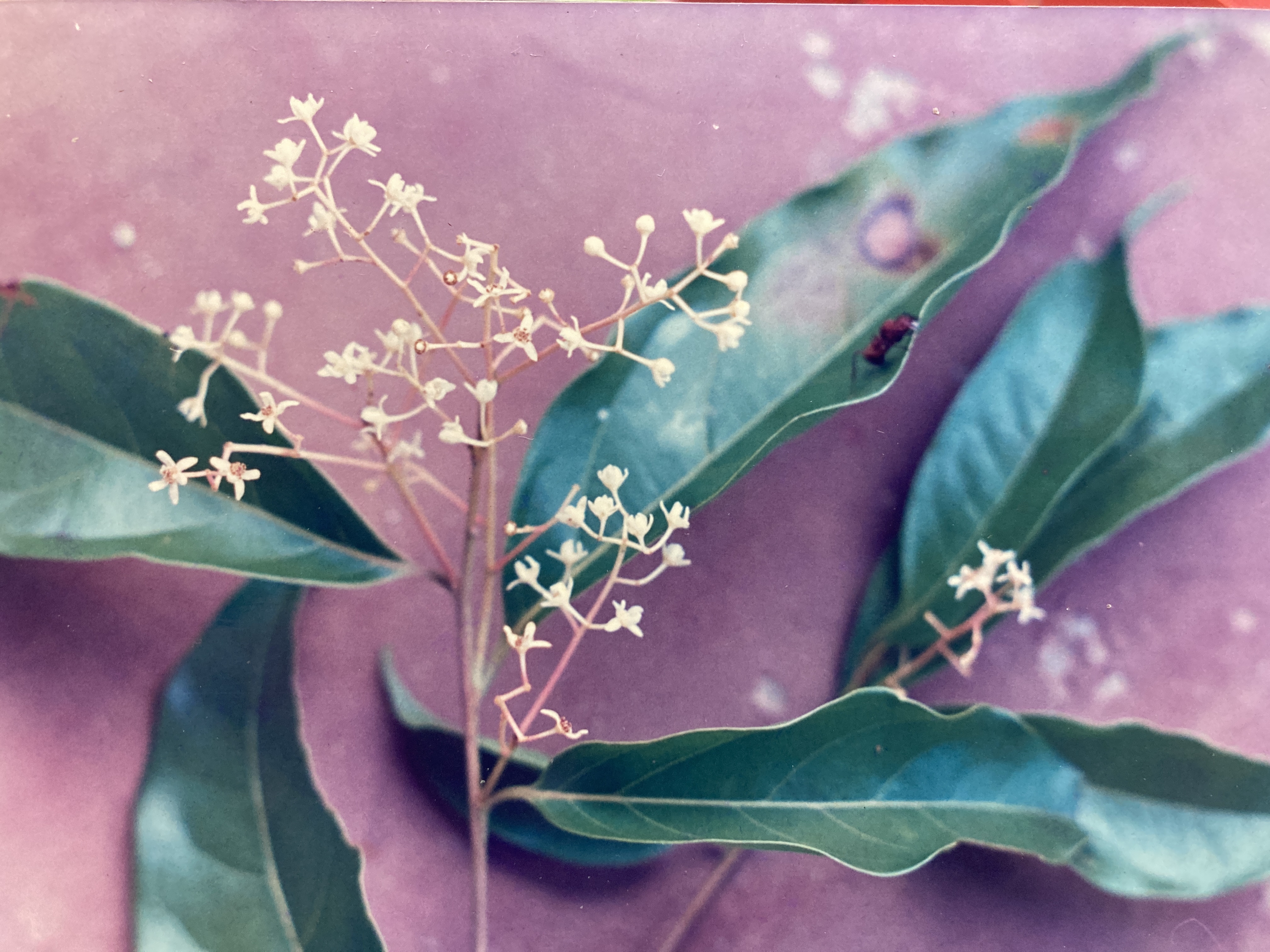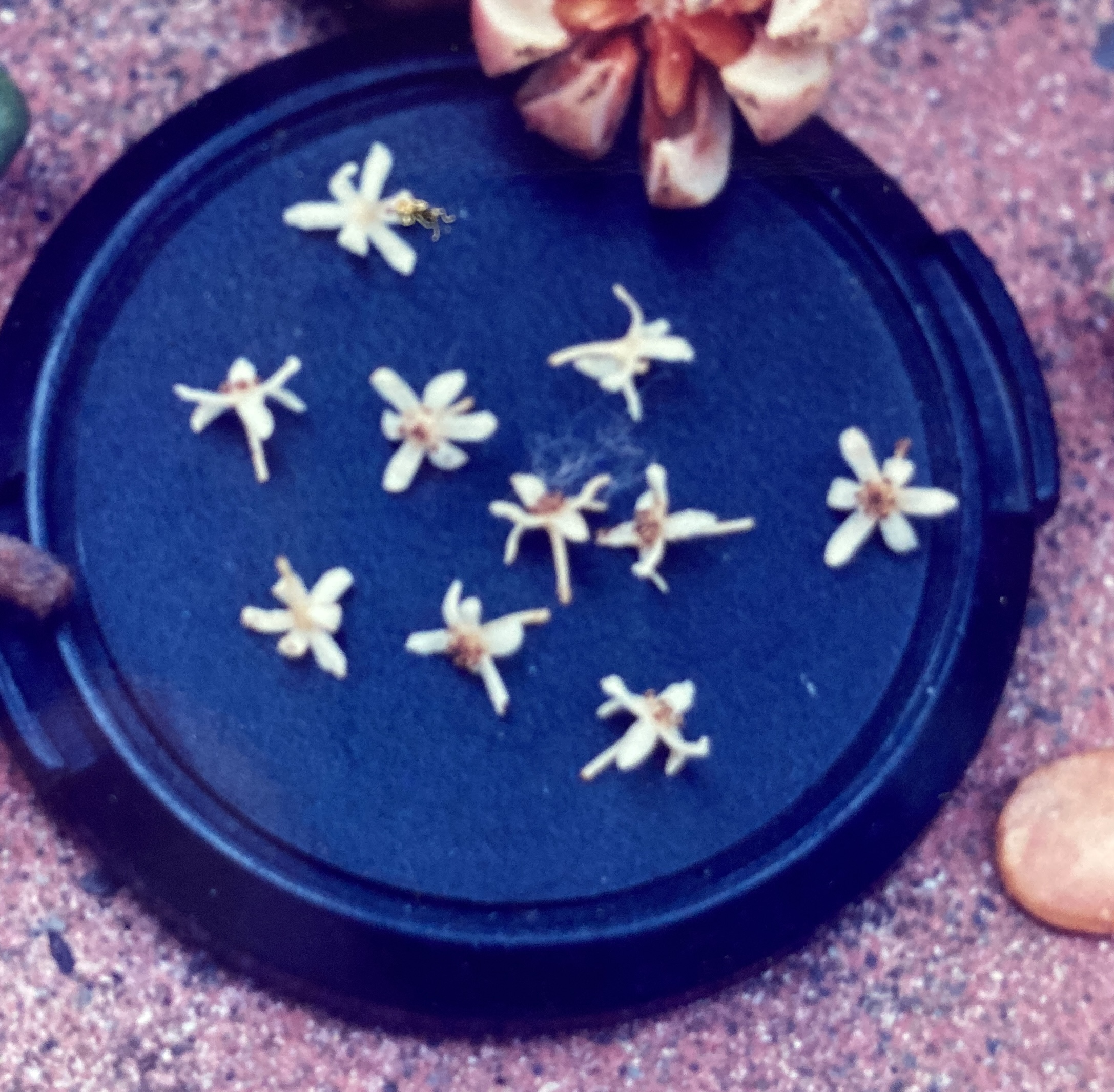Nectandra salicifolia (HBK) Nees.
Lauraceae
QUIZARRA AMARILLO, AGUACATILLO
Understory or occasionally subcanopy evergreen tree (15-20 m) found growing abundantly in Manuel Antonio’s primary forests. This species is an important component of the tropical ecosystem, thanks to the prolific quantities of much sought after fruits that it generates on an annual basis. Though absent from areas containing secondary vegetation, Quizarra Amarillo appears to possess many “pioneer” characteristics, doing best in forest light gaps and rarely achieving large stature.
Description: Quizarra Amarillo trunks are generally slight: only rarely do they exceed 20 cm in diameter. Circular in cross-section, they are not usually straight, with trees frequently bending as they rise through the forest understory. Larger trees show some development of low, straight and thin, ebony-colored buttresses. The bark is smooth, and light brown. Quizarra branches are restricted to very top of the bole, and a small, flat-topped, but thick crown is produced by them. Leaves (14 by 4.5 cm) are simple, alternately arranged, and smooth, with a papery texture. Each narrowly elliptical (spear-head shaped), glossy leaf tapers to a well developed drip-tip (2 cm) distally and a short petiole (0.5 cm) proximally. Often, the petioles and main leaf veins sport a reddish hue. New foliage – translucent, pink and limp – emerges from the branch tips. In some individuals, these new leaves possess a striking scarlet-red hue, contrasting favorably with the duller greens and browns of the forest. Most growth occurs in January and February, but new leaves may be seen sporadically throughout the year.
Pink-stemmed flower panicles (8 cm) emerge from the axils of the fresh foliage. Each small, white blossom (0.5 cm) presents a perianth composed of nearly identical sepals and petals. Narrow, minutely pubescent, and finger-like, the flower’s three sepals bend backwards and alternate with the three forward-bending petals. Multiple and minute – nearly invisible – stamens occupy the yellow flower center. Most trees produce flowers annually, although some seasons are skipped by isolated individuals. Blossoming can be quite prolific, with the upper crown of the trees acquiring a whitish, fuzzy, and veiled aspect during peak activity. Flowers are present from late April through May, with some sporadic fertility occurring as early as February. Fruits begin to develop immediately thereafter.
The old flower calyx swells into a large cup-shaped base that soon turns scarlet red and becomes an obvious feature in the crown. Each calyx holds an ovoid, glossy-green, white-speckled fruit (1.5-2 cm), shaped something like a small avocado. These mature into dark, black-purple drupes, each containing a single, rounded seed (1 cm) embedded in about 3 mm of soft, oily, avocado-like flesh. Spread thinly through the crown, the fruits are held amid the foliage by long, thin, and angular pedestals. Harvests are annual events, occurring from late August though October, with individual trees participating in roughly two out of every three seasons.
Similar Species: Nectandra salicifolia is a difficult tree to identify when sterile, for its leaves have a shape and arrangement that is not unusual in the humid tropical forest. Probably the best way to identify this species in the field is to locate shoots of new growth in the crown. These are sporadically visible at all times during the year and they sport the pink or red, expanding foliage typical of this tree.
Another species of Nectandra found in Manuel Antonio, N. globoso, is a tree of similar stature, leaf shape, and fruit anatomy. However, its flowers (though similar in form) are much larger (over 1 cm in diameter). N. globoso has much larger foliage as well, and its fruits – lacking N. salicifolia‘s prominent red calyx – are borne upright and in dense panicles.
Two other Lauraceae species (Ocotea veraguensis, Licaria excelsa) possess similarly shaped fruits to those of N. salicifolia. In both cases, however, the fruits are much larger (3 cm). Furthermore, Ocotea veraguensis (see account) is usually a short, 10 m tree and its fruit calyx possesses an apron-like, flared lip. Licaria excelsa is a larger tree (15 m), however its foliage is very thick, leathery, and twice the size of N. salicifolia‘s. Also, Licaria has an exceptionally thin and open crown.
Natural History: Flowers are bee and insect pollinated. Fruits are eaten by arboreal mammals like White-faced Monkeys and by birds of the Trogon family (e.g. Slatey-tailed). Many other Lauraceae species in Costa Rica produce small fruits almost identical to those of Nectandra salicifolia and all are collectively called “aguacatillos” (little-avocados) by local campesinos. The iridescently green, often red-bellied Trogons – including the infamous Quetzal – show a strong preference for this type of fruit. Where trees are harvesting, these birds can frequently be observed sallying out from the surrounding vegetation to pluck ripe aguacatillos while on the wing.
Uses: Nectandra has great value as a food-producing species for tropical forest fauna. It has fine-grained, yellow wood (hence its common name, Quizarra Amarillo) that finishes with a nice polish. It has been used in furniture making and interior finishing (Allen, 1956)).
Distribution: In Manuel Antonio National Park (MANP), Nectandra is common along the Puerto Escondido and Second Beach trails. Its ranges from northeastern Mexico to Panama.
Images: Flowers & Leaves Flowers & Leaves2 Flowers Fruits Fruits2 Fruit & Seed



